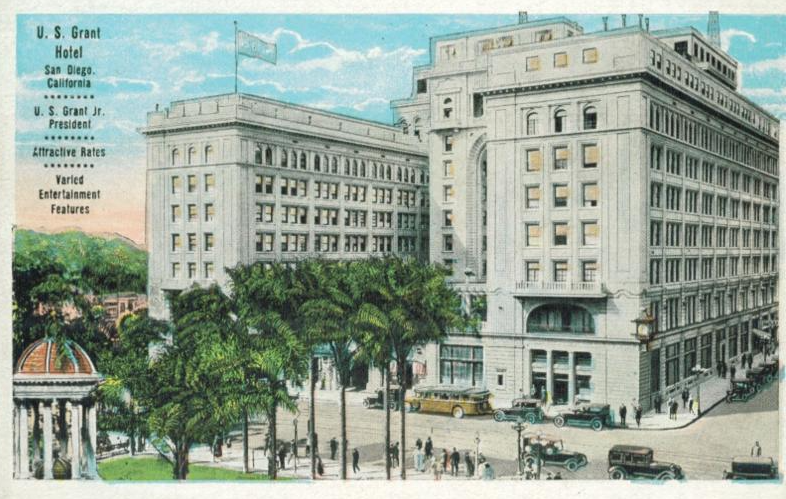No products in the cart.
Landmarks
The U.S. Grant Hotel
The U.S. Grant Hotel | 326 Broadway
Architect: Harrison Albright
Style: Classic Revival
When Alonzo Horton arrived in San Diego in 1867, he purchased what we now know as downtown San Diego for 271/2 cents an acre. He immediately set about laying out the city grid, selling lots and making improvements to what he described as “heaven on earth.” Within 20 years, the City had replaced Old Town as the commercial center and a stopping point for businessmen, tourists and shipping. One of Horton’s greatest contributions was the Horton House Hotel, San Diego’s first major hotel. This site was later to become the site of the nationally designated historic U.S. Grant Hotel.
At the turn of the 20th century, Ulysses S. Grant, Jr. or Buck Grant, as he was called, moved his family from New York to San Diego. He had suffered financial difficulties on Wall Street and felt that he needed a new start. He immediately began a series of investments – he made money, lost money and usually just broke even. However, his wife, Fannie Chaffee Grant, daughter of Jerome B. Chaffee, the first senator from Colorado, made the wise decision to buy the Horton House Hotel for $56,000. She then deeded the property to her husband.
Buck Grant was both adventurous, resourceful and imaginative. He believed that what San Diego needed was a truly grand hotel. Although his financial problems continued, his plan was to build such a hotel in memory of his father, Ulysses S. Grant, the 18th President of the United States. With little cash on hand, in 1906 he razed the Horton House, and began construction of his visionary project on the same site. Shortly after the first beams were put in place, San Francisco suffered a catastrophic earthquake, making the transfer and procurement of building materials almost impossible. The skeletal construction site of Buck’s visionary hotel remained sadly silent.
The construction resumed in 1907 and to celebrate the resumption of the project, Grant, Jr. embedded a time capsule in the arch above the main entrance. It contained personal family photos, memorabilia and newspaper clipping about the proposed hotel. More things were added in 1910 when the hotel opened, but the capsule was then lost, only to be rediscovered in 2005 by a local resident, Veva Haache. The capsule is now under a stone medallion in the elevator lobby.
It must be noted that Mr. Grant lacked the funds needed to complete the hotel, so San Diego voters helped finance the project with $700,000 of the required $1.5 million required for completion.
One year before the hotel was to open, the Grant family suffered yet another tragedy. Fannie Chaffee Grant, who had been in ill health, passed away on November 10, 1909. The daunting project was finally completed in 1910. It was a luxurious palace of 437 rooms featuring top floor arcade windows, balcony balustrades, and imposing dentil cornices. Additional features were two swimming pools, a Grand Ballroom on the top floor, and a sweeping Italian marble staircase with an alabaster railing that led from the massive tiled lobby to the elegant Palm Court above. The color scheme, shades of blue, reflected the Presidential blue shade and the ever-blue skies over San Diego.
Opening day, October 15, 1910 , was a day-long, and night celebration of epic proportions capped by the unveiling of a new fountain in the adjacent Horton Park Plaza. The fountain, a gift from the City, was the world’s first electrically-lit fountain, and was designed by prominent local architect, Irving Gill.

Although the hotel was partially refurbished in the 1980s, it declined and fell on hard times in the 1990s. It changed hands several times and was ultimately purchased by the Sycuan Band of the Kumeyaay Nation in 2003. It had been saved from demolition by its inclusion on the National Historic Registry. It was then closed, and after an extensive renovation, reopened in October of 2006. The Grand Ballroom was converted to two bi-level Presidential suites with magnificent views of the city. The evening primrose, the tribal flower of the Sycuan and Kumeyaay Nations, is featured throughout the hotel, including in the hand-milled carpet of the Grand Lobby, the ceilings of the Crystal Ballroom and the molding of the Chaffee Court.

Additional feature s are 33,000 square feet of meeting space spread over 22 venues and a Presidential Ballroom, which was once an open-air terrace designed by Kate Sessions, the landscaper of Balboa Park. The Grant’s signature restaurant, the Grant Grill, which was not open to ladies until 1969, was also fully restored to its original elegance.
As the Kumeyaay are one of four Native American tribes that are indigenous to San Diego, and who can trace their roots back 10,000 years, it seems more than fitting that they now own the land, which they originally controlled!

Throughout the years, the U.S. Grant has hosted 14 U.S. Presidents, Albert Einstein, Charles Lindbergh, the inaugural Comic Con festival, a speakeasy during Prohibition, the annual reunion of the Great White Fleet Association, a fancy nightclub called The Little Club, and the first Fireside Chat delivered by President Franklin Roosevelt outside of Washington D.C. The latter took place from the Grant’s 11th floor radio station, now the Presidential Penthouse Suite. And – the Grant owns one of only two existing portraits of President Ulysses S. Grant! The other hangs in the Smithsonian Institution in Washington, D.C.
The U.S. Grant still proudly overlooks Horton Plaza , and stands as a magnificent and stately reminder of an elegant past and one of San Diego’s most treasured landmarks.
Sandee Wilhoit is the historian for the Gaslamp Quarter Historical Foundation. She can be reached at [email protected].

